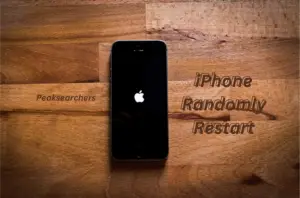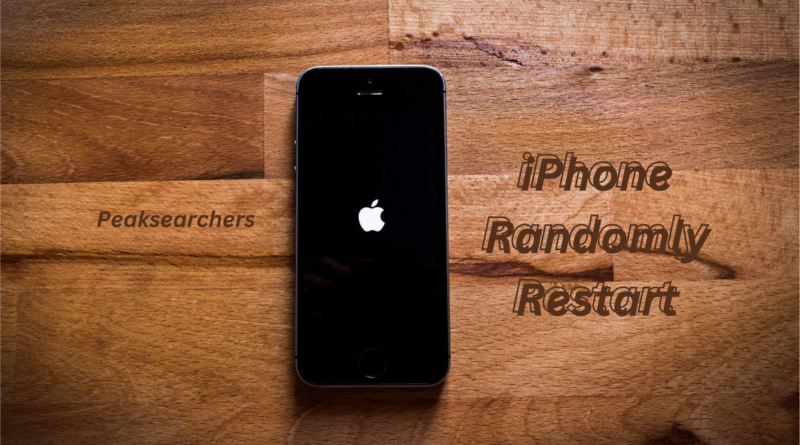Why Did My iPhone Randomly Restart? Troubleshooting and Solutions
Welcome to our comprehensive guide on troubleshooting iPhone randomly restart. If you’ve been experiencing unexpected restarts with your iPhone, you’re not alone. Random restarts can be frustrating, but fear not, as we have you covered with effective solutions to address this issue. A few months ago my iPhone was also facing the same issue continuously and I was very conscious about this problem so I Discussed the whole scenario with my elder brother and he guided me. In this article, we’ll delve into the possible causes behind these random restarts and provide step-by-step solutions to help you resolve the problem. Let’s get started!

Common Causes of Random iPhone Restarts
Software Glitches and Updates
One of the most common reasons for random restarts is software glitches or bugs. Sometimes, updates to the iOS can lead to unexpected issues, including frequent restarts. It is essential to keep your iPhone’s software up-to-date, but occasionally, new updates may bring unforeseen challenges.
Solution: If you suspect a recent update caused the problem, consider reverting to a previous iOS version until a stable update is released.
Overheating
Overheating is another culprit behind random restarts. Intensive tasks, prolonged usage, or exposure to high temperatures can cause your iPhone to overheat, triggering automatic restarts to prevent damage.
Solution: Ensure proper ventilation during use, avoid leaving your iPhone in direct sunlight, and close unnecessary background apps to reduce the load on your device.
Battery Issues
A deteriorating or damaged battery can also lead to sudden restarts. As batteries age, their capacity to hold a charge diminishes, causing unexpected shutdowns and restarts.
Solution: Check your battery health in the iPhone settings and consider replacing it if the capacity is significantly reduced.
Third-Party Apps
Certain third-party apps may not be optimized for your iPhone’s current software version, leading to compatibility issues that result in random restarts.
Solution: Identify and uninstall any recently installed apps and check for updates to existing ones.
Hardware Problems
While software issues are more common, hardware problems can also trigger random restarts. This may include faulty components or loose connections.
Solution: If you suspect hardware issues, it’s best to visit an authorized service center for diagnosis and repairs.
Step-by-Step Troubleshooting
Backup Your iPhone
Before attempting any troubleshooting, ensure you have a recent backup of your iPhone data. This ensures that no data is lost during the troubleshooting process.
Check for Software Updates
Examine any updates that might be available by going to Settings > General > Software Update. Continue with the installation of the update if it’s available.
Close Background Apps
To open the App Switcher, tap and hold the Home button twice (or swipe up from the bottom on newer devices). To exit an app, swipe up on it.
Reboot Your iPhone
Sometimes, a simple reboot can resolve software glitches causing restarts. Press and hold the power button until “slide to power off” appears, then slide it off. After a few seconds, turn your iPhone back on.
Reset All Settings
If the problem persists, try resetting all settings on your iPhone. Approach to Settings > General > Reset > Reset All Settings. Note that this will not delete your data but will reset preferences like Wi-Fi passwords and display settings.
Check Battery Health
Approach to Settings > Battery > Battery Health to check your battery’s maximum capacity. If it’s significantly degraded, consider getting it replaced.
Remove Recently Installed Apps
Uninstall any recently installed apps that might be causing conflicts.
DFU Restore
If none of the above steps work, you can try a Device Firmware Update (DFU) restore. This will erase all data on your iPhone, so make sure you have a backup. Instructions for DFU restore can be found on Apple’s support website.
Further Tips to Prevent Random iPhone Restarts
In addition to the troubleshooting steps mentioned above, implementing some preventive measures can help minimize the occurrence of random restarts in the future. Let’s explore some additional tips:
Avoid Overloading Your iPhone
Running too many apps simultaneously can strain your device’s resources and lead to overheating. Try to limit the number of apps running in the background and close unused ones regularly.
Monitor Battery Usage
Keep an eye on apps that consume excessive battery power. Go to Settings > Battery to view battery usage details. If you notice any app consuming an unusual amount of battery, consider reinstalling it or seeking an alternative.
Update Apps Regularly
Developers often release updates to fix bugs and enhance compatibility with the latest iOS versions. Keeping your apps up-to-date can reduce the chances of app-related issues causing random restarts.
Clear Cache and Data
Cached data can accumulate over time and cause performance issues. For apps that tend to store large amounts of cache, try clearing their cache or data periodically. You can do this in the Settings app under the “Storage” or “Apps” section.
Enable Low Power Mode
When your battery is running low, activating Low Power Mode can help conserve energy and reduce the likelihood of sudden shutdowns and restarts. You can enable this feature in Settings > Battery.
Disable Unnecessary Features
Some features like Location Services, Background App Refresh, and Push Notifications can consume more battery and resources. Disable them for apps that don’t require these features to run smoothly.
Check for Rogue Apps
Occasionally, a single misbehaving app can disrupt the overall stability of your device. If random restarts seem linked to a particular app, consider uninstalling and reinstalling it or reporting the issue to the app’s developer.
Keep Your iPhone Cool
Extreme temperatures can affect your iPhone’s performance. Avoid exposing it to direct sunlight or leaving it in hot environments for extended periods. Conversely, don’t use your device in extremely cold conditions, as this can also impact its performance.
Also Read: How to Turn Off Flash Notifications on iPhone? A Comprehensive Solution
FAQ’s
Why did my iPhone restart by itself?
There can be various reasons why your iPhone restarted by itself. Some common causes include:
- Software Updates: When your iPhone installs a software update, it might require a restart to complete the installation process.
- App Crashes: If an app on your iPhone encounters a critical error, it can cause the entire system to crash, resulting in a restart.
- Memory Issues: Sometimes, if your iPhone runs out of available memory, it may automatically restart to clear the memory and improve performance.
- Battery Problems: In cases of severe battery depletion or malfunction, your iPhone may shut down and restart as a safety measure.
- Overheating: When your iPhone’s internal temperature becomes too high due to heavy usage or exposure to extreme conditions, it might restart to prevent damage.
- Hardware Issues: Certain hardware problems or malfunctions can trigger an automatic restart.
- Software Glitches: Bugs or glitches in the operating system or specific apps can also cause unexpected restarts.
- Settings Changes: Sometimes, changes to system settings or configurations can prompt a restart to apply the changes.
- Network Issues: In rare cases, network-related problems can lead to a restart.
If your iPhone restarts occasionally and it doesn’t seem to be related to any specific actions you take, it is likely not a cause for major concern. However, if the restarts happen frequently or interfere with the normal usage of your device, it may be worth investigating further or contacting Apple Support for assistance.
Why did my iPhone randomly turn off?
If your iPhone randomly turned off without any input from you, there could be several reasons behind this unexpected shutdown:
- Battery Depletion: If your iPhone’s battery was critically low, it might have automatically turned off to preserve any remaining charge.
- Software Issues: Certain software glitches or bugs can cause the system to crash, leading to an abrupt shutdown.
- Overheating: When your iPhone gets too hot due to heavy usage or exposure to extreme temperatures, it may shut down to prevent damage.
- Hardware Problems: Issues with the battery, power button, or other internal components can cause unexpected shutdowns.
- Operating System Updates: During software updates, your iPhone may turn off and on as part of the installation process.
- Water or Physical Damage: If your iPhone suffered water damage or was subjected to physical trauma, it might result in an unexpected shutdown.
- Malfunctioning Apps: Certain apps could misbehave and cause the system to crash, leading to the phone turning off.
- Firmware Issues: Problems with the phone’s firmware or low-level software can also contribute to random shutdowns.
In case this was an isolated incident, you can try turning your iPhone back on and see if it functions normally. In case the problem persists or becomes frequent, you should consider checking for software updates, closing any problematic apps, or contacting Apple Support to diagnose and address the issue. If your iPhone is still under warranty, they may be able to provide assistance or arrange a repair if necessary.
How do I fix my iPhone restart loop?
If your iPhone is stuck in a restart loop, try these steps to fix it. First, force restart your device by following the appropriate method for your iPhone model.
Next, ensure your iPhone has enough charge and try updating to the latest iOS version through Settings. If the issue persists, attempt a hard reset using iTunes by connecting your iPhone to a computer, entering recovery mode, and choosing “Update” in iTunes.
If that doesn’t work, consider DFU mode, but remember it erases all data, so backup first. If none of these steps work, contact Apple Support for further assistance or visit an Apple Store. Regularly back up your iPhone to avoid data loss in case of unexpected problems.
Also Read: How to Perform a Soft Reset on iPhone 14? A Detail Guide
Conclusion
Random iPhone restarts can be frustrating, but with our comprehensive troubleshooting guide, you can now effectively address this issue.
By following the step-by-step solutions provided above, you increase the chances of resolving the problem and enjoying a stable iPhone experience once again.
Remember, if all else fails, it’s always a good idea to seek assistance from Apple’s support or visit an authorized service center.


